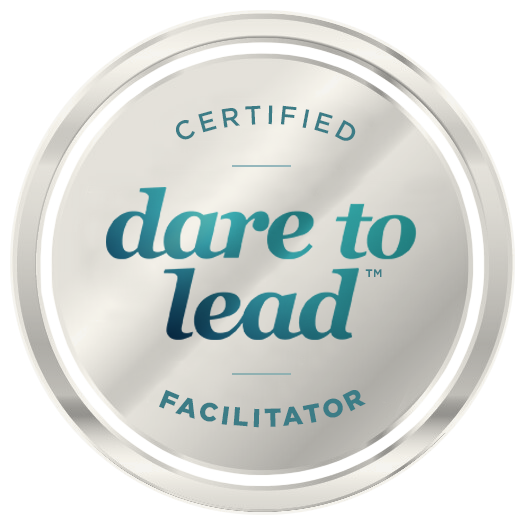Can organizations survive without innovation and creativity?
In the early stages of my business, I didn’t realize just how much it did matter. If I stayed focused, took care of our clients and delivered quality work on time, who had time for being creative?
The truth is, creativity and innovation are both risky and vital. It’s rare these days to listen to a business expert who isn’t talking about bringing more of each into the workplace. So what gets in the way? The problem we face is, we’re working against a powerful, unseen barrier that is so integrated into our culture we barely notice it. That persistent barrier is shame. Shame is the intensely painful feeling or experience of believing that I am flawed and therefore unworthy of love and belonging. And shame breeds fear.
Author and leadership expert Dr. Brené Brown looks deeply into the issues of courage, vulnerability, shame and empathy. In her book, Dare to Lead, she identified the most common way shame shows up in the workplace: when someone introduces — or attempts to introduce — a new concept or idea.
t’s an almost universal experience. The fear of being laughed at, ridiculed or belittled is often enough to keep good ideas bottled up and unshared. Even if I manage to push through, there’s another fear lurking right behind: the fear that I’m wrong or, worse yet, that I’ll fail.
It takes a shame-free environment to grow, adapt, create and innovate.
Shame in the Workplace?
Shame crushes an individual’s tolerance for vulnerability (defined as risk, uncertainty and emotional exposure). It kills healthy engagement, innovation, creativity, productivity and trust. Shame can ravage an organization because we usually don’t know what we’re looking for — and we don’t recognize it when we see it.
Look for these behavior cues to determine if shame exists in the organization’s culture. Shame shows up as blaming, gossiping, bullying, favoritism, nostalgia, comparison, snark, cover ups, finger pointing, teasing, avoidance, gatekeeping (the “meeting after the meeting”), name-calling and harassment.
In some organizations, shame is actually used as a management tool. Leaders may bully those around them, criticize or deliver reprimands in front of colleagues. Some organizations have created reward systems that leverage intentional belittling, shaming, comparison or even humiliation as a means of “motivating” other employees.
The Workplace Bullying Institute defines bullying this way: “Repeated mistreatment: sabotage by others that prevented work from getting done, verbal abuse, threatening conduct, intimidation and humiliation.”
A 2010 poll conducted by Zogby International reported that an estimated 54 million American workers (an enormous 37 percent of the U.S. workforce) have been bullied at work.
To make matters worse, shame rolls downhill. If employees are navigating shame, I can be confident they’re passing this negative beast on to customers and vendor partners. And when shame gets to be too much, people simply disengage. Even at average levels of workplace shame, they stop showing up, contributing, producing or even caring. If it’s extreme, disengaged employees can rationalize all kinds of unethical behavior, including lying, stealing and cheating.
The Blame Game
In organizations, schools and families, blaming and finger-pointing are often the most obvious symptoms of shame. From blame comes shame, along with hurt, denial, anger and retaliation. Blame is simply the discharging of pain and discomfort. I blame when I’m uncomfortable and experience pain — when I’m vulnerable, angry, hurt, feeling shame or grieving. There’s nothing productive about blame. I can’t think of a single situation in my career where blaming someone or something contributed to a good outcome or improved a relationship.
Building a Shame-Resilient Culture
In organizational cultures where the dignity and respect of individuals are held as its highest values, shame and blame don’t work as management styles. There is no “leading by fear.” Instead, empathy is a valued asset, accountability is an expectation, and our core human need for connection and belonging isn’t leveraged for social control.
We can cultivate workplaces where shaming behaviors are neither tolerated nor rewarded. We can make deliberate efforts to identify where shame might be showing up in the organization and in relationships with our clients and vendors. Flush it out, call it out and deal with it, even when it causes discomfort. We must support and train leaders who are willing to be courageous enough to facilitate honest and tough conversations about shame and its byproduct behaviors.
As a leader, I won’t solve the kind of complex issues I face today without fostering more creativity, innovation and engaged learning. As a daring leader, I risk choosing my short-term discomfort over resentment and shame, to nurture and create a thriving organization.
 After 40 years as president of her print and marketing company, Eileen Rogers’ encore career is now as a leadership coach and business advisor through her company One Creative View. She is a seasoned and accomplished entrepreneur and recognized community leader who is fiercely passionate about supporting and growing more vulnerable and courageous leaders. She is a certified Dare to Lead™ facilitator, Integrative Enneagram practitioner and executive coach.
After 40 years as president of her print and marketing company, Eileen Rogers’ encore career is now as a leadership coach and business advisor through her company One Creative View. She is a seasoned and accomplished entrepreneur and recognized community leader who is fiercely passionate about supporting and growing more vulnerable and courageous leaders. She is a certified Dare to Lead™ facilitator, Integrative Enneagram practitioner and executive coach.


















